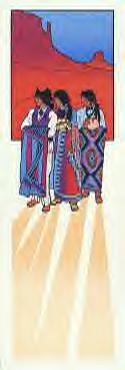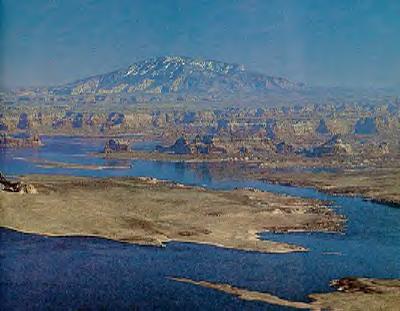|
 NAVAJO
MOUNTAIN -- The sacred mountain, its base gouged by red rock canyons and its top decorated with communication towers,
guards expanses of southern Utah. NAVAJO
MOUNTAIN -- The sacred mountain, its base gouged by red rock canyons and its top decorated with communication towers,
guards expanses of southern Utah.
It is a landmark for travelers. Boaters on Lake Powell use it to navigate. Hikers in Four Corners gauge distances
by its familiar, rounded profile off in the haze.
A dusty and rugged 20-mile dirt road connects the isolated little community on the Navajo Reservation to the rest
of the world.
Residents live in splendid isolation. Scattered homes, traditional Navajo hogans and a government housing project
are dots on the landscape. Phone service is spotty and expensive, adding to the solitude of this place just north
of the Arizona border and a matter of miles -- as the crow flies -- from Rainbow Bridge National Monument. The
nearest grocery store is 27 miles away.
The 40-student Navajo Mountain High School and the 140-student Naa Tsi Aan Elementary School are the most modern
structures.
For Jaime Holgate, a Navajo by birth, a carpenter by trade and elected vice president of the independent elementary
school board by choice, those schools are a wellspring of pride. He helped supervise their construction.
Holgate, a father of two boys who are now out of school and of a 10-year-old adopted daughter, remembers boarding
schools where young Navajos spent nine months a year away from home. He recalls places where military discipline,
complete with short haircuts, drills and rigid ceremony, was part of everyday life. English was the only language
allowed. Navajos caught using their native language would have their mouths washed out with soap.
As an adult, Holgate and others watched young Navajos change in frightening ways when forced to venture far from
home for school. Television and computer games replaced more traditional family life. There were drugs, liquor
and gangs.
He also became frustrated when dealing with the distant Bureau of Indian Affairs, especially when it came to the
management of the elementary school. When a window broke on a day when the temperature was below zero, it took
weeks to get fixed.
 Two years ago, Holgate and the other residents of the 300-square-mile area the elementary school
serves decided to become one of the Navajo nation's 33 grant schools. That meant the district would be managed
by a community-elected school board, while still receiving BIA funds. Two years ago, Holgate and the other residents of the 300-square-mile area the elementary school
serves decided to become one of the Navajo nation's 33 grant schools. That meant the district would be managed
by a community-elected school board, while still receiving BIA funds.
"We want to make sure the money gets to the kids," Holgate says, sitting in the library of the elementary
school surrounded by posters stressing American Indian contributions to world history. "The children are always
first."
That, plus a successful lawsuit that forced the San Juan County School District to build the high school, means
more students can return home at night and be a part of traditional Navajo family life. And those who must stay
in the dorms can often see their families on weekends because the travel distances are not so great. The community
board is considering adopting a four-day school week next year, allowing even more family time. Students can be
taught the Navajo language, stories and traditions along with the required English, math and science.
"The school is more for the people," says Susan Burdick, a native of Georgia who has served as a principal
and a teacher under both systems. "There is more community involvement than in the past."
That, more than anything, was what Jaime Holgate wanted. He sought quiet change in a quiet place.
Navajo Mountain History
http://www.media.utah.edu/medsol/UCME/n/NAVAJOMOUNTAIN.html
<+>=<+>
Information Pages: http://users.skynet.be/kola/index.htm
|
 NAVAJO
MOUNTAIN -- The sacred mountain, its base gouged by red rock canyons and its top decorated with communication towers,
guards expanses of southern Utah.
NAVAJO
MOUNTAIN -- The sacred mountain, its base gouged by red rock canyons and its top decorated with communication towers,
guards expanses of southern Utah. Two years ago, Holgate and the other residents of the 300-square-mile area the elementary school
serves decided to become one of the Navajo nation's 33 grant schools. That meant the district would be managed
by a community-elected school board, while still receiving BIA funds.
Two years ago, Holgate and the other residents of the 300-square-mile area the elementary school
serves decided to become one of the Navajo nation's 33 grant schools. That meant the district would be managed
by a community-elected school board, while still receiving BIA funds.